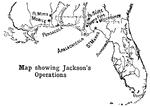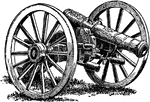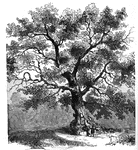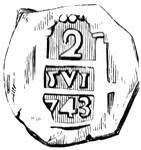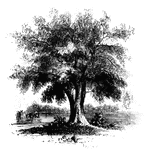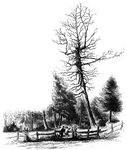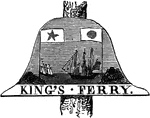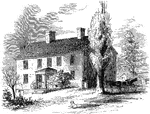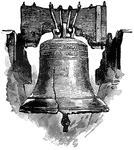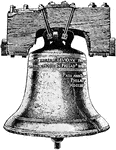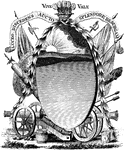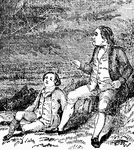The American Revolution Miscellaneous ClipArt gallery contains 98 illustrations of Continental money, the Liberty Bell, stamps of the Stamp Act, and other assorted images related to the American Revolution.

John Armstrong
(1755-1816) Explorer and soldier who was a militia officer in the American revolution.
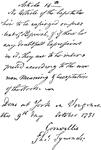
One of the Articles of Capitulation with Cornwallis's Signature
Lord Cornwallis Surrendered Yorktown to George Washington on October 19, 1781. The terms of surrender…

Bastile Key
"Key of the Bastile. This key of the old Paris prison known as the Bastile, was sent by La Fayette to…

Brant's Rock
Brant's Rock. This rock, which is about four feet high, lies in a field on the left of the road leading…

British Search
This is an illustration of the British searching the Colonial Americans for illegal items at the docks.
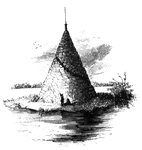
Cairn
Cairn on the St. Lawrence. This is probably the only structure of the kind on the American continent.…

Captain Cathcart
"Then came Lord Cathcart upon a powerful horse. He was chief of the knights. Two negro slaves wearing…
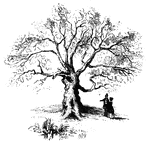
Charter Oak
The Charter Oak. This venerable relic is still virgorous, and is a "gnarled oak" indeed. It stands upon…

The Chew Coach
The coach car of a rich Tory judge, Judge Chew. He had a driver and footman in gold-laced cocked hats.

Clinton's Dispatch and Bullet
Henry Clinton wrote a dispatch to Burgoyne and enclosed it in an elliptical silver bullet, small enough…
Constitution Ratification Cartoon
Political cartoon from the Boston Intependent Chronicle June 12, 1788 regarding Virginia's…
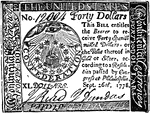
Continental Money
This forty dollar promissory note was a Continental paper bill that held almost no value during the…
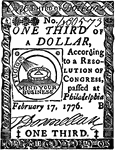
Continental Money
This third dollar promissory note was a Continental paper bill that held almost no value during the…
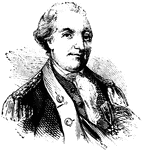
Baron De Kalb
(1751-1780) German soldier who fought along Lafayette in the American Revolutionary war
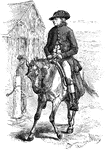
Ebenezer Dorr
"While Paul Revere is riding out through Medford, Ebenezer Door, mounted on an old plod-jogging horse,…
Flag Staff
"Flag-staff, Fort Washington. This flag-staff, indicating the center of the fort, is a prominent object…

Floating Battery
"American Floating Battery. I am indebted to the kindness of Peter Force, Esq., of Washington city (editor…

George Washington - Silhouette
A silhouette is "a profile portrait in black, so called after Etienne de Silhouette, French minister…
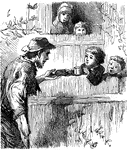
God Bless You
"It is a weary march. The soldiers are foot-sore, hungry, exhausted. Some drop from the ranks, and fall…

Isle Aux Noix
Isle Aux Noix, in the Sorel. The sketch was made from the pilot's room of the steam-boat, about half…

Sergeant Jasper
An American soldier who recovered the South Carolina flag and temporarily restored it during a battle…

The Jersey Prison Ship
One of the prisons used by the British at New York during the American Revolutionary War.
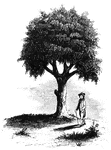
Liberty Tree
"Liberty Tree. I am indebted to the Hon. David Sears, of Boston, for this sketch of the 'Liberty Tree,'…
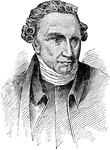
Minuteman Ready to Fight
A minuteman with his wife and son looks into the distance as he prepares to fight within a minute's…
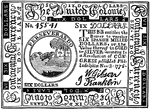
Continental Paper Money
This six dollar bill is an example of Continental paper money of the United colonies issued in 1776.

Relics of the Battle of Monmouth
The Battle of Monmouth was an American Revolutionary War battle fought on June 28, 1778 in New Jersey.
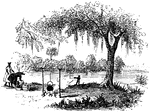
Nelson's Ferry
"About forty miles northwest of Charleston, near the line between Charleston and Orangeburg counties,…
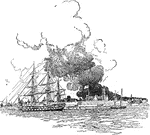
The Great Fire of New York in 1776
The Great Fire was a devastating fire that burned through the night of September 21 – September…

"The Temple," Newburg
With the Newburgh Addresses was privately circulated a notification of a meeting of officers at a large…
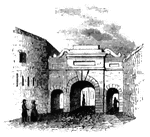
Palace Gate
Palace Gate, outside. This is one of the most beautiful gates of the city, and opens toward the St.…

Palace Gate
Palace Gate, inside. This sketch is a view from within Palace Street, looking out upon the open country…
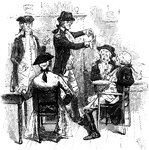
Major Pitcairn
Major John Pitcairn was one of the more reasonable officers of the British military. He was a Marine…
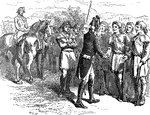
From the Right Bank of the Potomac
"One day there came marching into camp a regiment from Virginia, from the beautiful valley of the Shenandoah.…
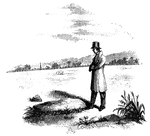
Queen Esther's Rock
Queen Esther's Rock. This view is near the ancient river bank, looking westward. The rock is a sort…

